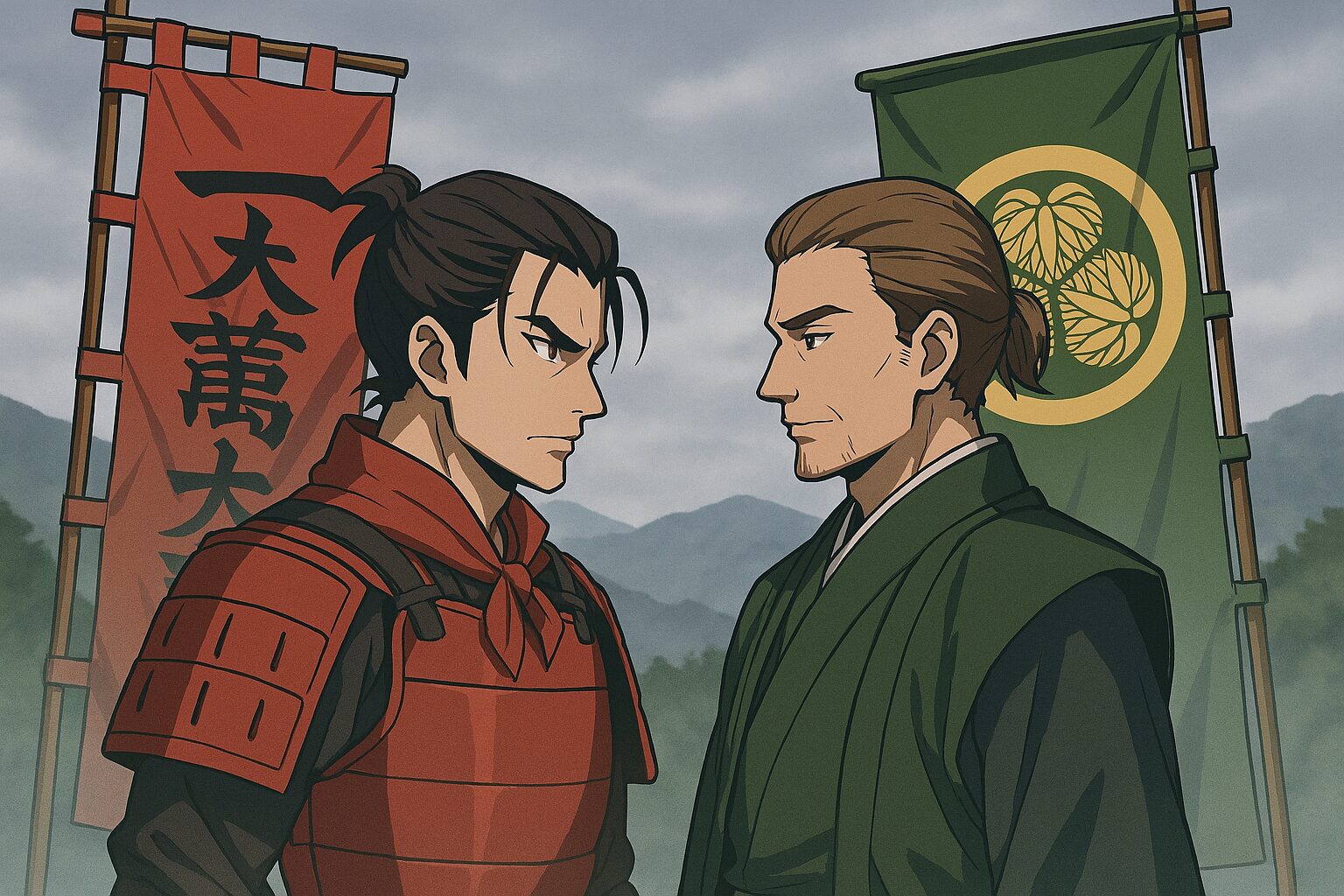The Decisive Battle that Signaled the End of the Warring States Period and the Dawn of the Tokugawa Era
October 21st. The significance of this date in Japanese history is immeasurable. It marks the day when the famously colossal battle known as the “Battle of Sekigahara (Sekigahara no Tatakai)” was fought—a battle that effectively brought the nationwide turmoil of the “Sengoku Jidai” (Warring States period) to an end and laid the foundation for the subsequent 260 years of peace, the “Edo Period.”
This battle broke out in Sekigahara, Mino Province (present-day Sekigahara Town, Gifu Prefecture) on the 15th day of the 9th month of the old calendar in the year 1600 (corresponding to around October 21st in the modern calendar). The structure of the conflict was both simple and immense: the “Eastern Army,” led by the supreme commander Tokugawa Ieyasu, who had rapidly gained power after the death of Toyotomi Hideyoshi, clashed with the “Western Army,” championed by Ishida Mitsunari, who pledged loyalty to the Toyotomi family and opposed Ieyasu’s growing dominance.
The “Unifier’s” Dream Lost in the Mists of History
The Battle of Sekigahara signifies more than just a military confrontation. It represents the collapse of the centralized system built by Toyotomi Hideyoshi and the ultimate game for the seat of the next “Unifier of Japan” (Tenka-bito).
The Western Army’s total force was about 80,000, against the Eastern Army’s about 90,000. The numbers were closely matched, and in the early stages, the Western Army held the advantage. Ishida Mitsunari utilized the terrain, rallying feudal lords like the Mori, Ukita, and Konishi to implement a strategy of encircling the Tokugawa forces. However, the true turning point—the factor that decided the outcome—was not strategy or manpower, but the human drama of “betrayal.”
The actions of Kobayakawa Hideaki, a general nominally aligned with the Western Army who had been secretly negotiated with (chōryaku) by Tokugawa Ieyasu, held the key to victory or defeat. He remained static for the first half of the battle, but following a “warning shot” from the Tokugawa arquebusiers, he finally defected to the Eastern Army, charging into the Western Army’s main camp. This shocking betrayal caused the Western Army’s command to disintegrate. The battle concluded in just half a day, a speed almost unprecedented in Japanese history.
Three years after this victory, Tokugawa Ieyasu was appointed Shogun by the Imperial Court, establishing the Edo Shogunate. Sekigahara became literally the “Decisive Battle for the Realm,” determining the final form of the “Age of the Samurai” and laying the groundwork for peace that lasted until Japan’s transition to a modern nation.
Interpreting Japanese Culture and “Graceful Defeat” from Sekigahara
The Battle of Sekigahara provides a vital lens for understanding Japanese culture, particularly the spirit of Bushidō (The Way of the Warrior) and organizational theory, beyond just a military engagement.
One aspect is the conflict between “Gi” (Righteousness) and “Ri” (Self-Interest). Ishida Mitsunari sought to uphold his “Gi” to the late Hideyoshi, but many feudal lords prioritized “Ri”—the safety of their domains and families—ultimately siding with Ieyasu. This ultimate choice between “Gi” and “Ri” is a universal theme, constantly debated even in modern Japanese society and business, when balancing personal belief against organizational profit.
Another is the culture of “Betrayal” and “Manipulation” (Chōryaku). While betrayal is often viewed as despicable in Japan, in the Warring States period, “Chōryaku”—deceiving the enemy, increasing allies, and winning without bloodshed—was a necessary skill for a superior general. Kobayakawa Hideaki’s action is often negatively described as the epitome of “Hiyorimi” (opportunism) by later generations, but it can also be seen as a “rational decision” made under extreme pressure for survival. Japan’s modern culture of “reading the air” (kūki o yomu) and the dual structure of public façade versus private intention may not be unrelated to this historical context.
Furthermore, the “gracefulness” of the loser, Ishida Mitsunari, is noteworthy. He never gave up until the end, maintaining a dignified composure even after his capture. His willingness to die for his beliefs symbolizes the Japanese cultural appreciation for the “Aesthetics of a Beautiful End” and the spirit of “Hōgan-biiki” (sympathy for the underdog/loser), which is why he remains beloved by many Japanese people today.
If You Stood at Sekigahara
When you learn about this epic tale of the Battle of Sekigahara, what thoughts come to mind?
Do you sympathize with Ishida Mitsunari, who upheld “Righteousness,” and feel sadness for his defeat? Or do you praise the “patience and strategy” of Tokugawa Ieyasu, who made a realistic judgment to secure victory and establish a peaceful era?
If you were a feudal lord standing on the battlefield of Sekigahara, under whose banner would you choose to fight? Would you pursue only “results” in the form of victory, or would you choose a beautiful defeat driven by “conviction”?
This “Decisive Day for the Realm,” which shaped Japanese history and culture, is a superb subject that compels us to deeply reflect on our own “way of living” and “values.” We encourage you to delve into the truth of this history and discover your own answer.
References and Related Links
- Sekigahara Town Tourist Association (Sekigahara Old Battlefield Memorial Museum)
- A facility where you can learn about the entirety of the Battle of Sekigahara with modern exhibits.
- https://sekigahara.pref.gifu.lg.jp/
- Tokugawa Ieyasu: His Life and the Establishment of the Edo Shogunate
- A detailed article exploring Ieyasu’s strategy and character.
- https://www.google.com/search?q=Tokugawa+Ieyasu+Life+and+Edo+Shogunate
壮大な歴史の転換点:10月21日は「関ケ原の合戦」の日
戦国の終焉と徳川の世の幕開けを告げた天下分け目の大決戦
10月21日、この日付が日本の歴史において持つ意味は計り知れません。それは、日本全土を巻き込んだ戦乱の時代、すなわち「戦国時代」に事実上の終止符を打ち、その後の約260年間にわたる平和な時代「江戸時代」の礎を築いた、あまりにも有名な一大決戦「関ケ原の合戦(せきがはらのたたかい)」が繰り広げられた日だからです。
この戦いは、西暦1600年旧暦9月15日(新暦では10月21日頃に相当)に、美濃国関ケ原(現在の岐阜県不破郡関ケ原町)で勃発しました。戦いの構図は極めてシンプル、かつ壮大でした。豊臣秀吉の死後、急速に力を増した徳川家康を総大将とする「東軍」と、豊臣家への忠誠を掲げ、家康の専横に反発した石田三成を盟主とする「西軍」が激突したのです。
歴史の霧の中に消えた「天下人」の夢
関ケ原の合戦は、単なる武力衝突以上の意味を持ちます。それは、豊臣秀吉が築き上げた中央集権体制が崩壊する過程であり、次の「天下人」の座を賭けた究極のゲームでした。
西軍の総兵力は約8万、対する東軍は約9万。兵力差は拮抗し、開戦当初、戦況は西軍優位に進みました。石田三成は、地の利を生かし、毛利、宇喜多、小西などの大名を糾合して徳川軍を包囲する戦略を取りました。しかし、この戦いの最大の焦点、そして結末を決定づけたのは、戦術や兵力ではなく、「裏切り」という名の人間ドラマでした。
西軍に属しながら、徳川家康の調略(裏工作)を受けていた小早川秀秋(こばやかわひであき)の動向が、勝敗の鍵を握っていました。彼は、戦いの半ばまで動かず静観していましたが、ついに徳川方の鉄砲隊による「威嚇射撃」をきっかけに東軍へ寝返り、西軍本陣に突撃しました。この衝撃的な裏切りにより、西軍の統率は崩壊。戦いはわずか半日で決着がついてしまうという、日本の歴史上類を見ないスピードで終結しました。
この合戦で勝利を収めた徳川家康は、その3年後、朝廷から征夷大将軍に任じられ、江戸幕府を開きます。関ケ原は、「武士の世」の最終形態を決定づけ、日本が近代国家へ至るまでの平和な基礎を確立した、文字通りの「天下分け目の大決戦」となったのです。
関ケ原から読み解く日本文化と「潔さ」
関ケ原の合戦は、単なる戦いとしてだけでなく、日本文化、特に武士道精神や組織論を深く読み解くための重要なレンズを提供します。
一つは、「義」と「利」の相克です。西軍の石田三成は、あくまで亡き秀吉への「義」を貫こうとしましたが、多くの大名たちは、自らの領地や家門の安泰という「利」を優先し、最終的に家康に靡きました。この「義」か「利」かという究極の選択は、現代の日本社会やビジネスシーンにおいても、個人の信念と組織の利益の間で常に議論される普遍的なテーマです。
もう一つは、「裏切り」と「調略」の文化です。日本では裏切り行為は卑劣なものと見なされがちですが、戦国時代においては、敵を欺き味方を増やし、血を流さずに勝つ「調略」は、優れた将の必須条件でした。この合戦での小早川秀秋の行動は、後世において「日和見(ひよりみ)」の代名詞として否定的に語られることが多いですが、生き残りをかけた極限状況下での「合理的な判断」と見ることもできます。現代日本の「空気を読む」文化や、表向きの建前と裏腹な本音が存在する二重構造は、こうした歴史的背景と無関係ではないかもしれません。
さらに、敗者である石田三成の「潔さ」も特筆すべきです。彼は最後まで諦めず、捕らえられた後も堂々とした態度を崩しませんでした。彼の信念に殉じる姿は、日本の文化が重んじる「散り際(ちりぎわ)の美学」や「判官びいき(ほうがんびいき)」(敗者や弱者に同情する感情)の精神を象徴しており、今なお多くの日本人から愛される理由となっています。
あなたが「関ケ原」に立つならば
この関ケ原の合戦という壮大な物語を知ったとき、あなたはどのような感想を抱くでしょうか。
あなたは「義」を貫いた石田三成に共感し、その敗北に涙を流しますか? それとも、現実的な判断で勝利を掴み、平和な世を築いた徳川家康の「忍耐と戦略」を賞賛しますか?
もしあなたが関ケ原の戦場に立つ大名の一人だったとしたら、あなたはどちらの旗の下で戦うことを選びますか? 勝利という「結果」のみを追求するのか、それとも「信念」という名の美しい敗北を選ぶのか。
日本の歴史と文化を形作ったこの「天下分け目の日」は、私たち自身の「生き方」と「価値観」について、深く考えさせられる最高の教材と言えるでしょう。ぜひ、この歴史の真実を掘り下げ、あなた自身の答えを見つけてみてください。
参考文献・関連リンク
- 関ケ原古戦場記念館
- 関ケ原の戦いの全容を最新の展示で学べる施設です。
- https://sekigahara.pref.gifu.lg.jp/
- 徳川家康:生涯と江戸幕府の樹立
- 家康の戦略と人物像に迫る詳細な記事。
- https://www.google.com/search?q=徳川家康+生涯+と+江戸幕府



コメント